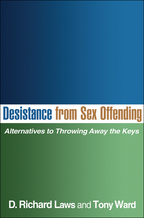Desistance from Sex Offending
Alternatives to Throwing Away the Keys
D. Richard Laws and Tony Ward
1. Introduction
II. The Criminological Perspective
2. Defining and Measuring Desistance
3. The Age–Crime Curve: A Brief Overview
4. Theoretical Perspectives on Desistance
5. Factors Influencing Desistance
6. Two Major Theories of Desistance
III. The Forensic Psychological Perspective
7. Do Sex Offenders Desist?
8. Sex Offender Treatment and Desistance
IV. Reentry and Reintegration
9. Barriers to Reentry and Reintegration
10. Overcoming Barriers to Reentry and Reintegration
V. Recruitment
11. The Unknown Sex Offenders: Bringing Them in from the Cold
12. Blending Theory and Practice: ACriminological Perspective
VI. Desistance-Focused Intervention
13. The Good Lives Model of Offender Rehabilitation: Basic Assumptions, Etiological Commitments, and Practice Implications
14. The Good Lives Model and Desistance Theory and Research: Points of Convergence
15. The Good Lives–Desistance Model: Assessment and Treatment
VII. Where to from Here?
16. Dignity, Punishment, and Human Rights: The Ethics of Desistance
17. Moral Strangers or One of Us?: Concluding Thoughts



